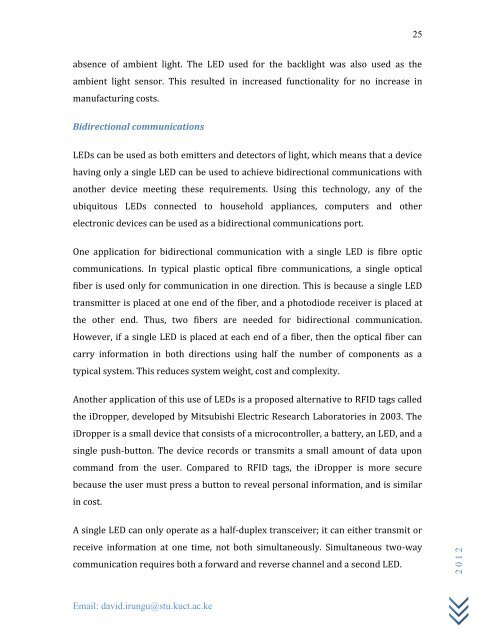SOLAR PV CONTROL SYSTEM.pdf
Create successful ePaper yourself
Turn your PDF publications into a flip-book with our unique Google optimized e-Paper software.
absence of ambient light. The LED used for the backlight was also used as the<br />
ambient light sensor. This resulted in increased functionality for no increase in<br />
manufacturing costs.<br />
Bidirectional communications<br />
LEDs can be used as both emitters and detectors of light, which means that a device<br />
having only a single LED can be used to achieve bidirectional communications with<br />
another device meeting these requirements. Using this technology, any of the<br />
ubiquitous LEDs connected to household appliances, computers and other<br />
electronic devices can be used as a bidirectional communications port.<br />
One application for bidirectional communication with a single LED is fibre optic<br />
communications. In typical plastic optical fibre communications, a single optical<br />
fiber is used only for communication in one direction. This is because a single LED<br />
transmitter is placed at one end of the fiber, and a photodiode receiver is placed at<br />
the other end. Thus, two fibers are needed for bidirectional communication.<br />
However, if a single LED is placed at each end of a fiber, then the optical fiber can<br />
carry information in both directions using half the number of components as a<br />
typical system. This reduces system weight, cost and complexity.<br />
Another application of this use of LEDs is a proposed alternative to RFID tags called<br />
the iDropper, developed by Mitsubishi Electric Research Laboratories in 2003. The<br />
iDropper is a small device that consists of a microcontroller, a battery, an LED, and a<br />
single push-button. The device records or transmits a small amount of data upon<br />
command from the user. Compared to RFID tags, the iDropper is more secure<br />
because the user must press a button to reveal personal information, and is similar<br />
in cost.<br />
A single LED can only operate as a half-duplex transceiver; it can either transmit or<br />
receive information at one time, not both simultaneously. Simultaneous two-way<br />
communication requires both a forward and reverse channel and a second LED.<br />
Email: david.irungu@stu.kuct.ac.ke<br />
25<br />
2012



